
Provided by Devolver Digital
Inscryption: Winning Isn’t Everything
This piece contains spoilers for Inscryption
Back in the early 2010s, I was a part of an online Dungeons & Dragons campaign. It was my first real foray into the tabletop role-playing experience and I liked it a lot because I’ve always been better at becoming a character in text over sitting around a table face-to-face and acting it out.
The majority of the players in this D&D group, including the dungeon master, were very fond of getting into character and really selling their roles and motivations. But there was one guy who was not big into role play. Instead, he loved to min-max stats and tried to break as many combat scenarios as he could. His half-ogre Treg was super strong and could turn most enemies to paste in one or two turns, which gave the dungeon master problems because he had to balance encounters around a whole party, not just a single juggernaut. The rest of us were taking abilities and stats that felt right for our characters and sort of winging it. This made encounters balanced for Treg super difficult for the rest of us, while monsters balanced for us would melt if the half-ogre looked at them funny.
I thought about this old D&D campaign a lot as I played through Daniel Mullins Games’ Inscryption, a game where these two opposite philosophies on how to play a game also clash. Inscryption, at its outset, is a very tense and moody game. The cabin you’re in drips with atmosphere (literally, in the case of a bottle of talkative ooze) as you play through a roguelike deckbuilder version of a tabletop game against your captor, Leshy. He acts as the game master and is the guardian of this escape-room-like setting, and every step you take is drenched with his flair for showy narration of vibrant and engaging lore.
But for all of his strengths as a narrator and storyteller, Leshy’s game is balanced rather poorly. He gives you many opportunities to create cards that break the game in favor of establishing his spooky setting. His passion is for the story of the game and the characters created within. As he begins boss battles, he dons a mask and embodies that character, whether it’s the angler that wants to gut you alive or a seemingly friendly trapper who now wants to take and sell your pelt.
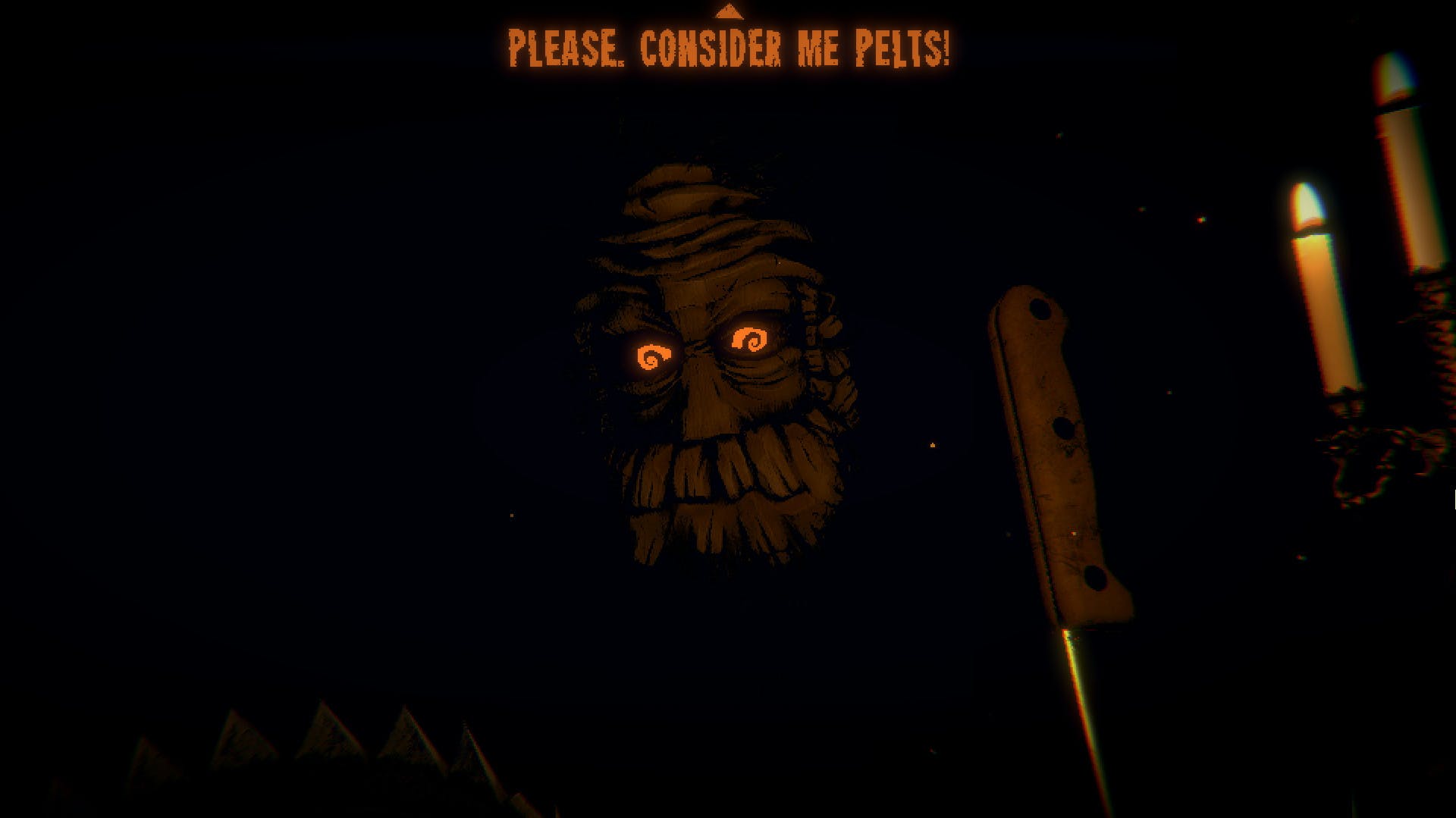
In Leshy’s Inscryption, the game is never about winning. Leshy doesn’t care if you succeed or fail—each run ends with him taking your picture and starting over again. If it weren’t for outside forces working against his deckbuilding game, it would be a traditional roguelike experience, with runs that can go on and on forever. Left to his own devices, Leshy would be content to play this version of the game forever, win or lose.
Footage from pre-launch trailers of the game were almost entirely taken from this first act in Leshy’s cabin, suggesting that this dark roguelike deckbuilder is the entirety of the game. But Inscryption’s focus shifts after completing tasks around the cabin and trapping Leshy inside of a card. Through meta elements about the game, it’s revealed that Inscryption has secretly been a more singularly linear narrative game than expected at first blush. In actuality, you are playing the game as Luke Carder, a trading card game booster pack opening YouTuber who stumbled onto the fictional Gamefuna Software’s strange ‘Inscryption’ game floppy disk and is trying to figure out what is going on inside. The second act of the game is about Carder playing through the original form of Inscryption (a more traditional Trading Card Game) and defeating Leshy and the other Scrybes of the game before that game’s ending is hijacked by one of them.
In Act 3, another character decides to act as a game master: the robot, P03. His game is at odds with Leshy’s style; he has no love for characterization and has no flair for the dramatic, barely managing to pretend to come up with a setting and story for his “Botopia” game. P03 does not care about lore or narrative design—mechanical strategy is all that matters in his game. He is the min-maxer. When you first meet him he’s so proud of his big accomplishment: adding a fifth lane to the board (“Leshy could never pull that off,” he says with a smirk). While Leshy’s game had the unique playstyle of sacrificing your own creatures to summon larger beasts—which partly leads to the greater imbalance of his section—P03’s game involves a more simplified Hearthstone style of gaining energy every turn, an established style of play that is much easier to balance and fine-tune a game around.
P03’s Inscryption is sterile and lacks any sort of interesting flavor. His intro to his version of the card game is vague and he doesn’t bother giving you any motivation – there are four evil robots and you have to go stop them. The end. Go get some cards, you n00b. And unlike the spooky dread that fills Leshy’s cabin, wandering around P03’s lair sparks no emotion. Most of the puzzles are retreads of previous puzzles (and one even has the same answer!) showing that P03 has very little imagination. It also feels like it goes on for way too long, which is in and of itself the point. Leshy’s section is punchy; it grips you and never lets go. P03’s section wears out its welcome because its DM gives not one iota of crap about whether you’re enjoying the game you’re playing.
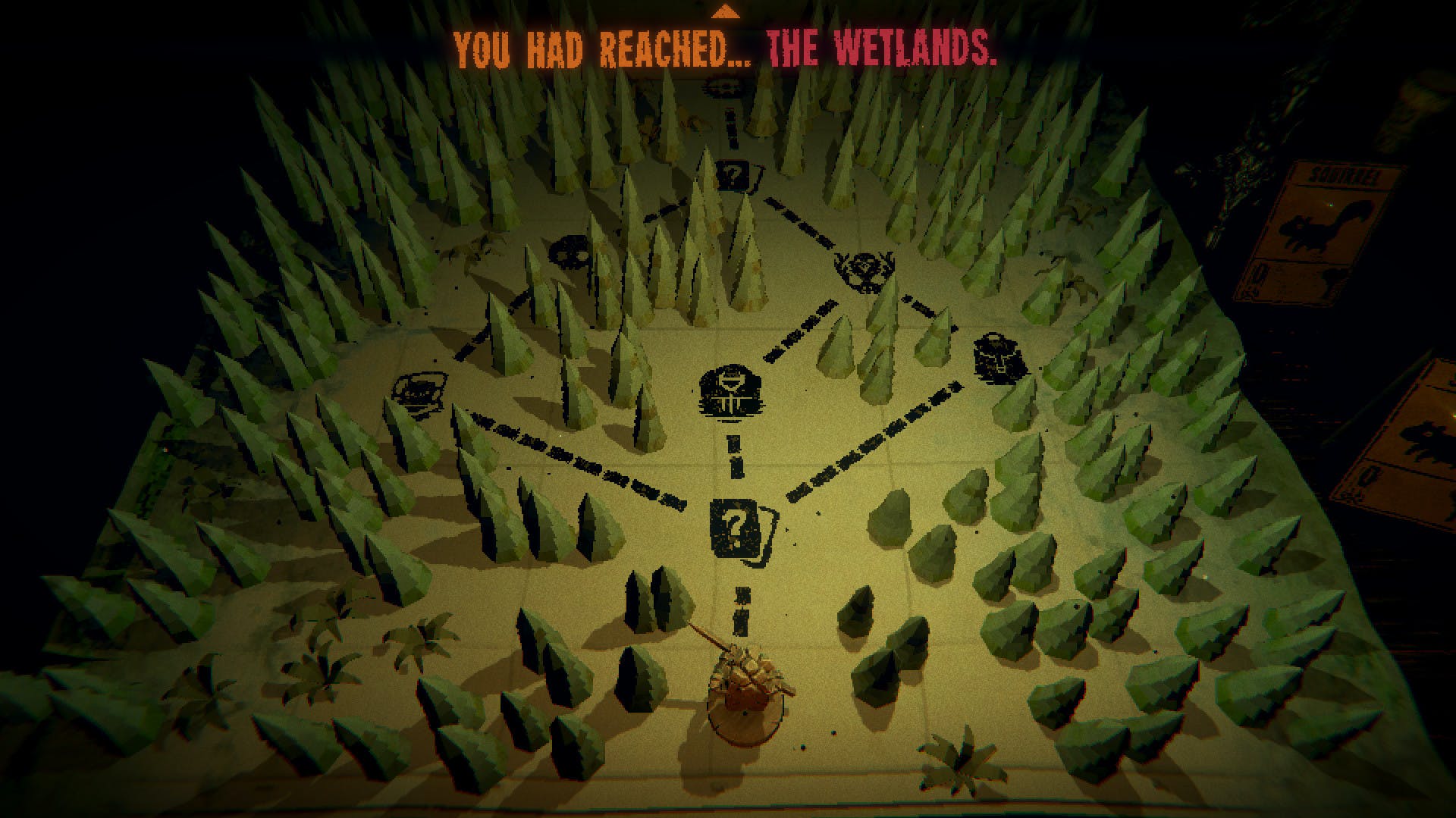
In looking at these two acts of the game, it’s important to note that neither of these creators are generating their version of Inscryption from scratch. In-universe, both characters are taking the data and card game that exist within the Inscryption’s original floppy disk and using the elements of design they care about to reshape the game into their own image. For Leshy the photographer, the woodland creatures of his domain and the brutality of nature that exists near his hut form that picture. P03, instead, draws upon the efficiency of energy and the manufacturing of machines and downloading new data. The struggle they have to coexist comes from the fact that both view their own incomplete game as whole. Even after they’ve each added in a mechanic from one of the other scribes—Leshy with Grymora’s bones, and P03 with Magnificus’s moxen—neither is able to create a game that feels satisfyingly complete.
Creating a flavorful, balanced card game is hard. Every card in a game is made to directly represent something present in the world of the game, whether it’s a lowly Stoat or towering Urayuli. While the purely functional design of a game might want a card that is evasive and unblockable or a card that can kill other cards, it’s the narrative flavor that decides that those cards are a Kingfisher and an Adder. The flavor of a card gives it a metaphor and makes it easier for a player to understand and internalize—birds fly, snakes bite and kill, and Urayuli are bigger than stoats.
But as this representation gets more specific, it can lead to questions that the cards can’t directly answer. ‘Lots of birds eat frogs, why can this Bullfrog eat a Sparrow?’ ‘Why does my Mantis care that a card has Stinky?—mantises can’t smell.’ ‘How does my Moose Buck shove a tentacle creature in a lake to the side?’ Everyone wants to let lore and worldbuilding shine where they can, but solid gameplay has to triumph in the end. This isn’t a struggle exclusive to Inscryption’s card game, either. Things can occasionally get silly in a straightlaced fantasy game like Magic: The Gathering, but if you want to have a game in which a Knight can pick up a Giant Hammer without too much rules baggage, that same hammer’s going to be able to be picked up by a Cat, too. To make a game flow, these narrative sacrifices must be made.
Even beyond its card game, Inscryption isn’t safe from this mechanical separation. At one point in the opening act of the game you pick up a knife, begging the obvious question of ‘can I use this against my captor?’ This idea is quickly dashed when one attempts to use the item in a game the first time. To my own surprise, I turned the knife against myself and plucked out an eye to win an inconsequential match that my hand would have made quick work of anyways. The knife, like everything else, is a game piece stuck in its function.
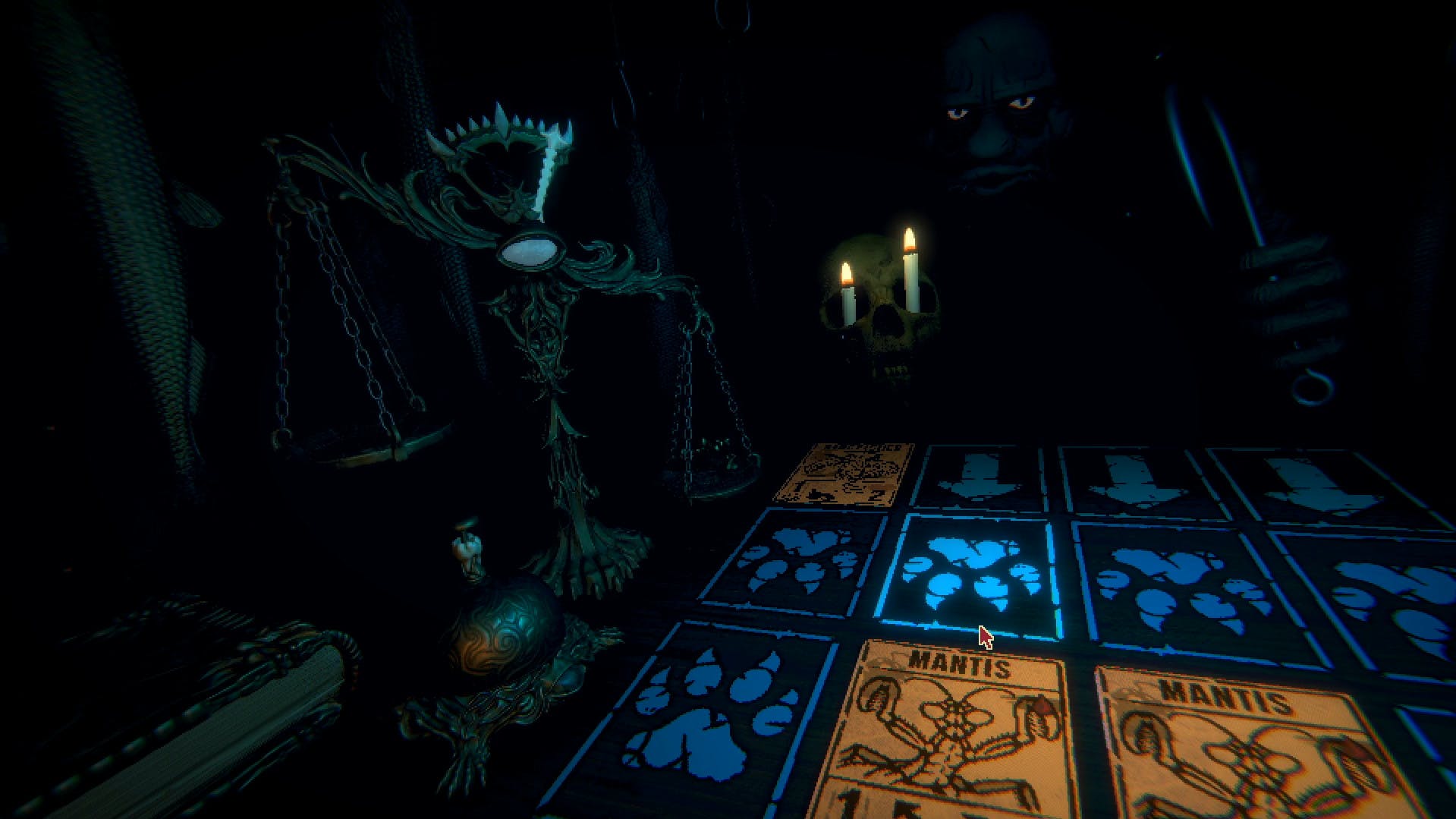
In order to facilitate the game’s multi-act narrative structure, the opening act of the game needs to be unbalanced and allow for ‘broken’ plays to give players the footholds they need to beat their captor and break free. In addition to the worldbuilding that Leshy establishes in-game, the cabin itself also gives you ample opportunity to break the game you’re trapped in. Leshy lets you roam around picking up items like the knife and rare cards as rewards for solving its escape room puzzles. Leshy incorporates these back into his game, weaving them into his existing story so he can continue his narrative regardless of how powerful they might be.
Unlike most of the card games that inspired it, Inscryption sacrifices gameplay balance in the service of fulfilling its narrative throughout. Cards like the Oroboros, which improves during each run of the game and can be obtained in each act, constantly push against a balanced game design in favor of forward narrative progression. Daniel Mullins Games’ Inscryption is a game that demands to be broken, even if that means destroying Gamefuna’s Inscryption in the process.
Inscryption’s subversion of the typical structure of roguelike deckbuilders is one of the first hurdles many people familiar to the genre have to struggle against. After finishing the game for the first time, I immediately turned to Twitch streams, hoping to watch others get caught up in the games twists and turns like I had. One particular streamer I watched was familiar with deckbuilders like Slay the Spire, so he thought he knew what he was getting into. But he also brought with him those hours upon hours of stratagem and was focused on the one thing all those other games drill into you—winning the run.
There’s only one time in his game where Leshy panics, and that’s when you go too far too fast. He has his tutorial baked into the start of the game, and his tutorial expects you to die. Due to the unbalanced nature of this act of the game and the game expecting you to break it, it’s easy for knowledgeable players to get further than he expects. If you do, Leshy’s eyes glow red as he breaks his own rules and summons a horde of flying grizzlies that are a near impossible feat to get past.
You’re supposed to die to them. You’re supposed to lose because losing unlocks a way forward in the story—another cleverly concealed point of the narrative structure of the overall game.
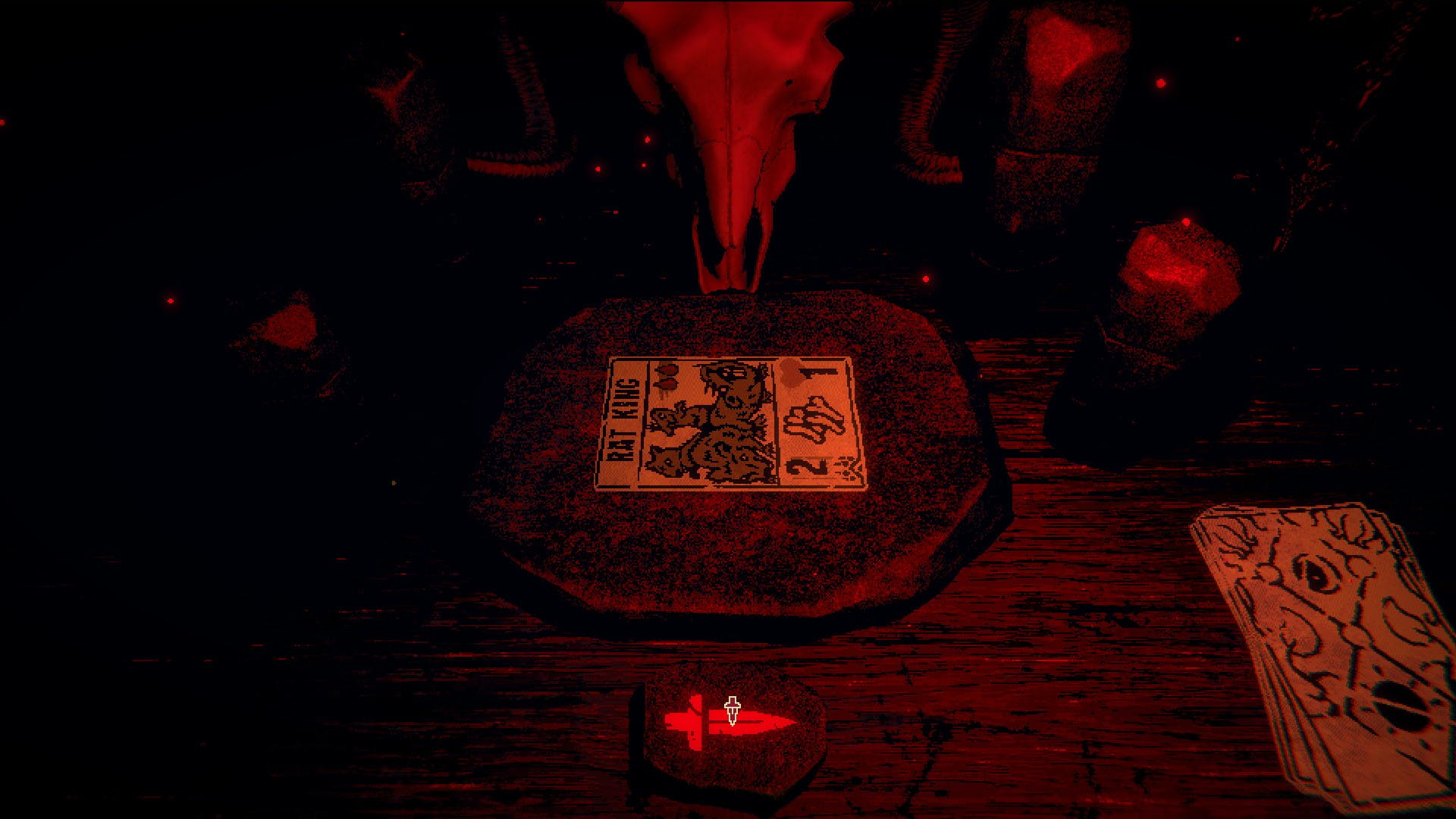
But if you’re smart enough, if you’re intrepid enough, if you’re clever enough, you can get past the grizzlies and win anyway. And Leshy’s eyes stay angry as you keep playing. That’s what this streamer did. He won, and won, and won some more. He used the overpowered tools given in the game like Oroboros to consistently finish runs and ‘beat’ the game multiple times. But he couldn’t progress the plot because he hadn’t lost to unlock the information he needed. I couldn’t help but laugh watching this occur: a player so good he couldn’t stop winning every run. I certainly wasn’t good enough to pull that feat off, so I’d never considered that winning could possibly impede progression.
Which brings me back to my original point: Inscryption is never a game about winning. P03, the character most directly interested in making sure Carder wins, does so with an ulterior motive. P03 goads you forward, acting like he’s smarter than the player and brushing off any progress you make as luck. And as it turns out, his master plan is fooling you into thinking you’re winning so you unknowingly help him out. Every step forward you make is actually a step forward for him. When you finally beat his four evil robot bosses, you have the rug pulled out from under you as you discover you haven’t actually won anything—P03 is the actual winner here, and that’s why he didn’t care about making the game entertaining. He never cared about his game or its story at all.
P03 is the metaphorical half-ogre pushing forward to win at any cost, because winning is all that matters to him. Leshy, on the other hand, uses the narrative device of a role playing game to push you forward and tell a story. Even in the second act, when he is no longer in charge of the game you’re playing, the majority of your interactions with Leshy take the form of him narrating your actions back to you. Once defeated, he says “Surely the summit of victory is made sweeter by a more arduous ascent.”
When you reach the game’s conclusion, you face off with Leshy one last time as the game and its pieces are deleted around you. Even once the scoreboard vanishes, Leshy will play for the sake of playing—he enjoys the arduous ascent that much. Even though he was your captor the last time you met at this table with this deck, it’s hard not to ultimately see him as a lost figure reminiscing on his stories as he reaches out to shake your hand and say “Good Game” as he and his world fade away. No winners, no losers, just two people playing a game of cards at the end of the world.
There’s a lot to take away from Inscryption—it’s a masterpiece of game design. But I think my most important takeaway is to stop focusing on winning, and start focusing on enjoying the game. Take in the sights and smells and love the journey, not the destination.





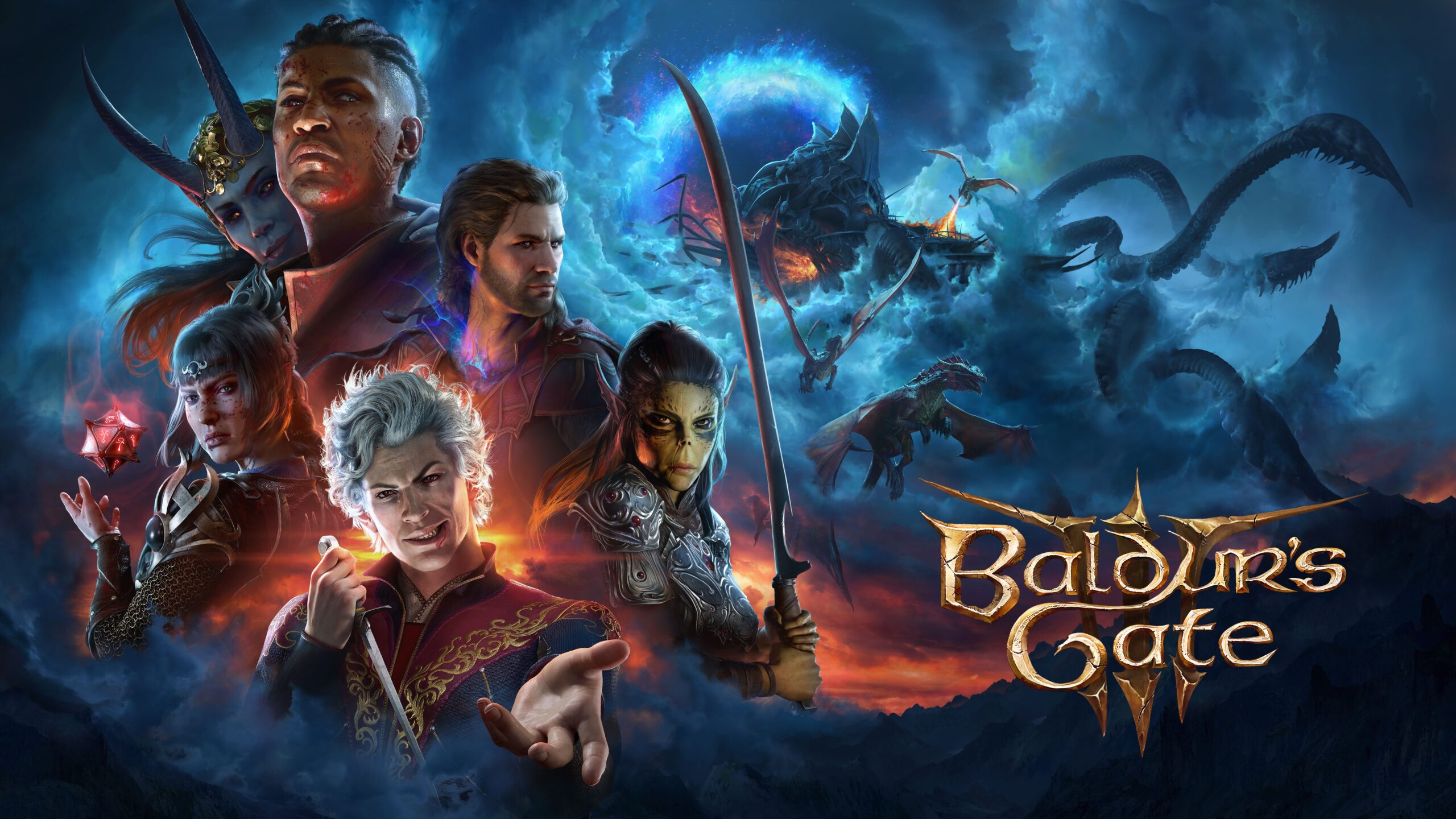
1 thought on “Inscryption: Winning Isn’t Everything”